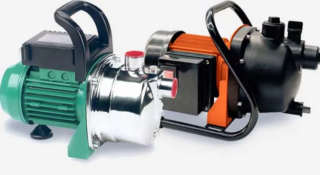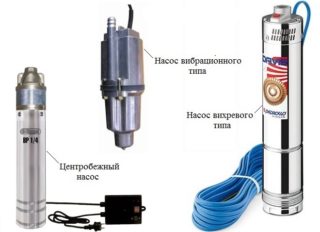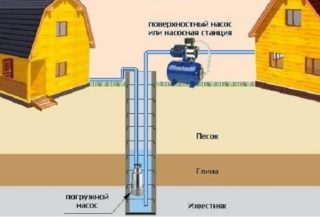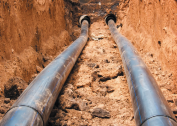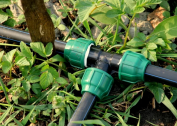A well on a summer cottage or private house site provides an opportunity to get clean water for technical and garden purposes. In some cases, wells are even suitable for providing residents of the house with drinking water, but in these situations, special equipment is required to pump water from them. Well pumps are the equipment that you need to choose based on the characteristics of the well.
The main types of pumps
The type of well pump affects its cost, as well as technical capabilities. There is a standard classification dividing aggregates into 2 main types:
- Equipment for installation on the surface. Surface pumps are placed 1-2 m from the well. Water in them due to rarefaction rises up, and then collects in a special container. However, to take water from great depths - from 9 m or more - by such units is extremely difficult. Such a technique works through a valve that prevents water from flowing back. Most often, surface models are used with a large vertical well. However, there is a separate subtype of surface pumps - water-pressure domestic stations. The main disadvantage of this type is the need for protection against precipitation and comparative noise.
- Submersible technique. Water equipment contains in one case the engine and the working tank. Unlike ground equipment, it requires complete immersion in the well. They fix the equipment with special cables.
Each type of pump has separate subspecies. Understanding their characteristics will help to understand how each of them works and for what conditions is suitable.
Types of surface equipment
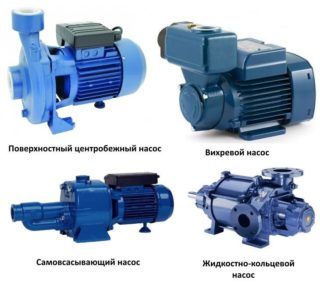 The simplest form of ground pumps is hand-held devices, which are considered the most inexpensive and are suitable for installation in a well or well. It is best suited for installation in homes with unstable electricity.
The simplest form of ground pumps is hand-held devices, which are considered the most inexpensive and are suitable for installation in a well or well. It is best suited for installation in homes with unstable electricity.
The action is triggered by the muscular force exerted by man. Best suited for use with shallow wells. The water obtained by such a pump is suitable for irrigation and domestic needs. Hand assembly design:
- cylinder;
- fluid ejection piston;
- air and water valves;
- lever for activating the piston.
A hand pump can be purchased in addition to electrical equipment and used when there is no power supply.
Self priming pumps
The devices are suitable for working in wells up to 10 m deep. Self-priming pumps are often equipped with a centrifugal element, which pumps water through the hose from the source. However, you will have to constantly monitor the heating of the case, as they are prone to overheating.
To get rid of this problem, there are additional units that cool the pump. However, such equipment is still not suitable for full-fledged water supply to a suburban area.
Pumping domestic stations
The station consists of a high-power self-priming pump and a hydraulic accumulator that maintains the required pressure. For automatic operation, pumping stations are equipped with control units that control performance. Surface stations are suitable for wells up to 10 m deep.
Stations with ejector and injector elements
Suitable for working with wells deeper than 10 m. Ejector and injection elements allow you to create an additional circuit with a reduced cross-section through which water passes and its speed increases.Such stations are ideal for working with wells up to 25 m deep. However, the equipment has some disadvantages:
- low productivity;
- loud noise.
Install stations in a separate technical room that can reduce noise.
Varieties of submersible models
Like surface mechanisms, submersibles are represented by such a variety as centrifugal units. They consist of 2 elements: a surface motor and a submersible module. But there is equipment that is made in a sealed enclosure and immersed in water.
Centrifugal elements are suitable for working with wells up to 7 m and have the following design:
- case with 2 sets of nozzles: intake and discharge;
- coupling connecting the housing to the drive;
- working mechanism with a shaft in the form of a wheel.
Inside, ICE or electric motors are used. Before use, these models require the addition of water. They are characterized by high reliability and ease of use.
Vibrating pumps
Another common variety of submersible equipment is vibration units, one of the most popular is the “Kid” pump. They differ in small dimensions, low power and minimum weight. However, such pumps can easily carry out their functions, although they create a lot of noise.
Consist of the following elements:
- steel case containing all the working mechanisms;
- piston activated by an electromagnetic vibrator.
Using the equipment is very simple, it does not need specific care. However, these pumps are not suitable for sand wells, as they begin to wear out quickly and break.
Among the advantages of the operation of vibration pumps is the possibility of use in heated and alkaline liquids. It is important to use such units only away from other equipment that could be affected by strong vibrations.
Screw pumps
This variety is suitable for use in contaminated water. Neither centrifugal nor vibrational models are suitable for these purposes so well. Screw units work according to the following principle:
- a long screw screw takes water;
- then it is distilled through a hose into the tank.
The design of the pumps is designed in such a way that fine debris and sand does not penetrate into it when the liquid is distilled.
Submersible screw pumps are the only equipment that does not suffer from contaminated media at all. With their help, you can distill dirty liquid into tanks and clean it with additional methods.
Vortex submersible pump
Vortex equipment is equipped with a wheel with blades at the edges, which ensure the movement of water from the nozzle to the outlet. The pressure in the equipment gradually increases, and the fast speed creates a vortex of liquid. After the liquid exits the nozzle, it is pushed up into the reservoir in which it accumulates.
Even with a low head, vortex pumps provide high pressure, which is the main advantage of the technology. Therefore, it is reasonable to use a vortex aggregate in wells with a minimum water level. However, it is impossible to use them in contaminated conditions.
Most of the models of vortex units are designed to work at a depth of up to 30 m, but there are more advanced options that raise water from a depth of up to 100 m.
Equipment selection options
 It is necessary to draw up the selection criteria for the pump before purchase. There are several critical parameters:
It is necessary to draw up the selection criteria for the pump before purchase. There are several critical parameters:
- Water consumption. You can see the characteristic in the equipment passport. Before buying, you need to establish the size of the well: diameter, height of the liquid.
- Head of water supply. The value is indicated as the height to which water is supplied. For the choice, it is necessary to take into account the height difference between the points of the well, the pressure value for independent leakage of water, the loss in conjugation of other channel elements.The numbers are summarized by the formula.
- Depth of immersion and diameter of the source. These indicators will affect the brand, the level of immersion of the equipment, as well as its suitability for use in a particular soil.
There are several well-known well pump manufacturers that deserve attention.
Equipment Brands
The industry leaders include the following manufacturers:
- Italian brand Aquario - manufactures industrial and domestic equipment;
- Wilo is a German company that sells pumps since 1872 and has earned worldwide recognition;
- Aquarius is a Ukrainian brand that produces excellent equipment for transporting water since 1995;
- Gileks - a Moscow-based corporation engaged in the manufacture of pumps since 1993;
- Pedrollo - Italian factory engaged in the production of electric pumps since 1974;
- Whirlwind - a Russian brand with unrivaled quality, has been operating since 1974;
- ESPA is a Spanish corporation that has offered the world many innovations in pumping technology.
The choice of brand depends on the type of pump used, the required power. As for the country of production, all these companies offer excellent quality equipment.
Pump installation and maintenance
Installation of submersible electrical equipment in most cases can be done on their own. It is enough to follow the instructions: the device is immersed in a shaft on a special cable and fixed. However, experts do not recommend using a cable in plastic. An electric cable is installed next to the cable.
A more sophisticated technique that does not sink into the well requires stationary installation. For her, it is necessary to create conditions that protect against direct sunlight and water.
Device cost
In online stores, the prices of water pumps for a well are significantly different from each other. This is due to the type of equipment, brand, technical specifications.
Automatic models of high pressure pumps can reach a cost of 40-50 thousand rubles or more. Submersible borehole pumps cost from 5000 rubles.
